7.2: Nuclear Energy
- Page ID
- 69424
\( \newcommand{\vecs}[1]{\overset { \scriptstyle \rightharpoonup} {\mathbf{#1}} } \)
\( \newcommand{\vecd}[1]{\overset{-\!-\!\rightharpoonup}{\vphantom{a}\smash {#1}}} \)
\( \newcommand{\dsum}{\displaystyle\sum\limits} \)
\( \newcommand{\dint}{\displaystyle\int\limits} \)
\( \newcommand{\dlim}{\displaystyle\lim\limits} \)
\( \newcommand{\id}{\mathrm{id}}\) \( \newcommand{\Span}{\mathrm{span}}\)
( \newcommand{\kernel}{\mathrm{null}\,}\) \( \newcommand{\range}{\mathrm{range}\,}\)
\( \newcommand{\RealPart}{\mathrm{Re}}\) \( \newcommand{\ImaginaryPart}{\mathrm{Im}}\)
\( \newcommand{\Argument}{\mathrm{Arg}}\) \( \newcommand{\norm}[1]{\| #1 \|}\)
\( \newcommand{\inner}[2]{\langle #1, #2 \rangle}\)
\( \newcommand{\Span}{\mathrm{span}}\)
\( \newcommand{\id}{\mathrm{id}}\)
\( \newcommand{\Span}{\mathrm{span}}\)
\( \newcommand{\kernel}{\mathrm{null}\,}\)
\( \newcommand{\range}{\mathrm{range}\,}\)
\( \newcommand{\RealPart}{\mathrm{Re}}\)
\( \newcommand{\ImaginaryPart}{\mathrm{Im}}\)
\( \newcommand{\Argument}{\mathrm{Arg}}\)
\( \newcommand{\norm}[1]{\| #1 \|}\)
\( \newcommand{\inner}[2]{\langle #1, #2 \rangle}\)
\( \newcommand{\Span}{\mathrm{span}}\) \( \newcommand{\AA}{\unicode[.8,0]{x212B}}\)
\( \newcommand{\vectorA}[1]{\vec{#1}} % arrow\)
\( \newcommand{\vectorAt}[1]{\vec{\text{#1}}} % arrow\)
\( \newcommand{\vectorB}[1]{\overset { \scriptstyle \rightharpoonup} {\mathbf{#1}} } \)
\( \newcommand{\vectorC}[1]{\textbf{#1}} \)
\( \newcommand{\vectorD}[1]{\overrightarrow{#1}} \)
\( \newcommand{\vectorDt}[1]{\overrightarrow{\text{#1}}} \)
\( \newcommand{\vectE}[1]{\overset{-\!-\!\rightharpoonup}{\vphantom{a}\smash{\mathbf {#1}}}} \)
\( \newcommand{\vecs}[1]{\overset { \scriptstyle \rightharpoonup} {\mathbf{#1}} } \)
\(\newcommand{\longvect}{\overrightarrow}\)
\( \newcommand{\vecd}[1]{\overset{-\!-\!\rightharpoonup}{\vphantom{a}\smash {#1}}} \)
\(\newcommand{\avec}{\mathbf a}\) \(\newcommand{\bvec}{\mathbf b}\) \(\newcommand{\cvec}{\mathbf c}\) \(\newcommand{\dvec}{\mathbf d}\) \(\newcommand{\dtil}{\widetilde{\mathbf d}}\) \(\newcommand{\evec}{\mathbf e}\) \(\newcommand{\fvec}{\mathbf f}\) \(\newcommand{\nvec}{\mathbf n}\) \(\newcommand{\pvec}{\mathbf p}\) \(\newcommand{\qvec}{\mathbf q}\) \(\newcommand{\svec}{\mathbf s}\) \(\newcommand{\tvec}{\mathbf t}\) \(\newcommand{\uvec}{\mathbf u}\) \(\newcommand{\vvec}{\mathbf v}\) \(\newcommand{\wvec}{\mathbf w}\) \(\newcommand{\xvec}{\mathbf x}\) \(\newcommand{\yvec}{\mathbf y}\) \(\newcommand{\zvec}{\mathbf z}\) \(\newcommand{\rvec}{\mathbf r}\) \(\newcommand{\mvec}{\mathbf m}\) \(\newcommand{\zerovec}{\mathbf 0}\) \(\newcommand{\onevec}{\mathbf 1}\) \(\newcommand{\real}{\mathbb R}\) \(\newcommand{\twovec}[2]{\left[\begin{array}{r}#1 \\ #2 \end{array}\right]}\) \(\newcommand{\ctwovec}[2]{\left[\begin{array}{c}#1 \\ #2 \end{array}\right]}\) \(\newcommand{\threevec}[3]{\left[\begin{array}{r}#1 \\ #2 \\ #3 \end{array}\right]}\) \(\newcommand{\cthreevec}[3]{\left[\begin{array}{c}#1 \\ #2 \\ #3 \end{array}\right]}\) \(\newcommand{\fourvec}[4]{\left[\begin{array}{r}#1 \\ #2 \\ #3 \\ #4 \end{array}\right]}\) \(\newcommand{\cfourvec}[4]{\left[\begin{array}{c}#1 \\ #2 \\ #3 \\ #4 \end{array}\right]}\) \(\newcommand{\fivevec}[5]{\left[\begin{array}{r}#1 \\ #2 \\ #3 \\ #4 \\ #5 \\ \end{array}\right]}\) \(\newcommand{\cfivevec}[5]{\left[\begin{array}{c}#1 \\ #2 \\ #3 \\ #4 \\ #5 \\ \end{array}\right]}\) \(\newcommand{\mattwo}[4]{\left[\begin{array}{rr}#1 \amp #2 \\ #3 \amp #4 \\ \end{array}\right]}\) \(\newcommand{\laspan}[1]{\text{Span}\{#1\}}\) \(\newcommand{\bcal}{\cal B}\) \(\newcommand{\ccal}{\cal C}\) \(\newcommand{\scal}{\cal S}\) \(\newcommand{\wcal}{\cal W}\) \(\newcommand{\ecal}{\cal E}\) \(\newcommand{\coords}[2]{\left\{#1\right\}_{#2}}\) \(\newcommand{\gray}[1]{\color{gray}{#1}}\) \(\newcommand{\lgray}[1]{\color{lightgray}{#1}}\) \(\newcommand{\rank}{\operatorname{rank}}\) \(\newcommand{\row}{\text{Row}}\) \(\newcommand{\col}{\text{Col}}\) \(\renewcommand{\row}{\text{Row}}\) \(\newcommand{\nul}{\text{Nul}}\) \(\newcommand{\var}{\text{Var}}\) \(\newcommand{\corr}{\text{corr}}\) \(\newcommand{\len}[1]{\left|#1\right|}\) \(\newcommand{\bbar}{\overline{\bvec}}\) \(\newcommand{\bhat}{\widehat{\bvec}}\) \(\newcommand{\bperp}{\bvec^\perp}\) \(\newcommand{\xhat}{\widehat{\xvec}}\) \(\newcommand{\vhat}{\widehat{\vvec}}\) \(\newcommand{\uhat}{\widehat{\uvec}}\) \(\newcommand{\what}{\widehat{\wvec}}\) \(\newcommand{\Sighat}{\widehat{\Sigma}}\) \(\newcommand{\lt}{<}\) \(\newcommand{\gt}{>}\) \(\newcommand{\amp}{&}\) \(\definecolor{fillinmathshade}{gray}{0.9}\)Nuclear Energy Consumption
The use of nuclear energy presents an interesting dilemma. On the one hand, nuclear electricity produces no carbon emissions, a major sustainable advantage in a world facing climate change. On the other hand, there is environmental risk of storing spent fuel for thousands or hundreds of thousands of years, societal risk of nuclear proliferation, and the impact of accidental releases of radiation from operating reactors. Thoughtful scientists, policy makers, and citizens must weigh these advantages and disadvantages.
Nuclear electricity came on the energy scene remarkably quickly. Following the development of nuclear technology at the end of World War II for military ends, nuclear energy quickly acquired a new peacetime path for inexpensive production of electricity. Eleven years after the end of World War II, a very short time in energy terms, the first commercial nuclear reactor produced electricity at Calder Hall in Sellafield, England. The number of nuclear reactors grew steadily to more than 400 by 1990 (figure \(\PageIndex{1}\)), four years after the Chernobyl disaster in 1986 and eleven years following Three Mile Island in 1979 (see Consequences of Nuclear Energy). The number of operating reactors remained approximately flat for two decades, and the United States has not built a new nuclear facility since 1996. The number of operating nuclear power plants decreased in 2011, when the meltdown at the Fukushima Daiichi Nuclear Power Station caused Japan to shut down all of its nuclear power plants. Japan has since resumed use of some of its nuclear reactors.
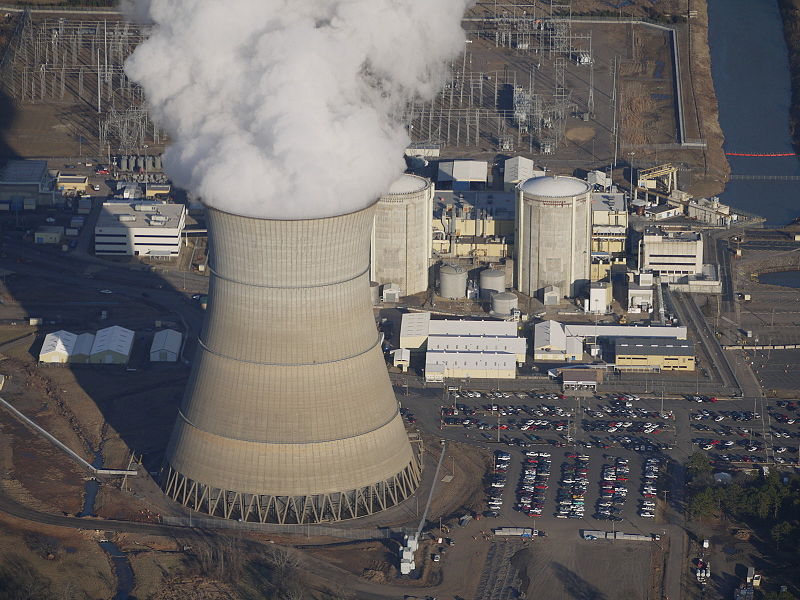
Figure \(\PageIndex{1}\): Arkansas Nuclear One, a power plant in Russellville, Arkansas. Image by Edibobb (CC-BY).
World production of electricity from nuclear power was about 2795.96 terawatt-hours (TWh) in 2019, comprising 10.4% of electricity production and 4.3% of total energy consumption globally (figure \(\PageIndex{2}\)). (For reference, the U.S. generated about 4100 TWh of electricity total in 2019.) The United States produced and consumed about 30.5% of the world's nuclear power in 2019, where nuclear power provided about 19.6% of the electricity and 8.0% of the total energy consumption (figure \(\PageIndex{3}\)).
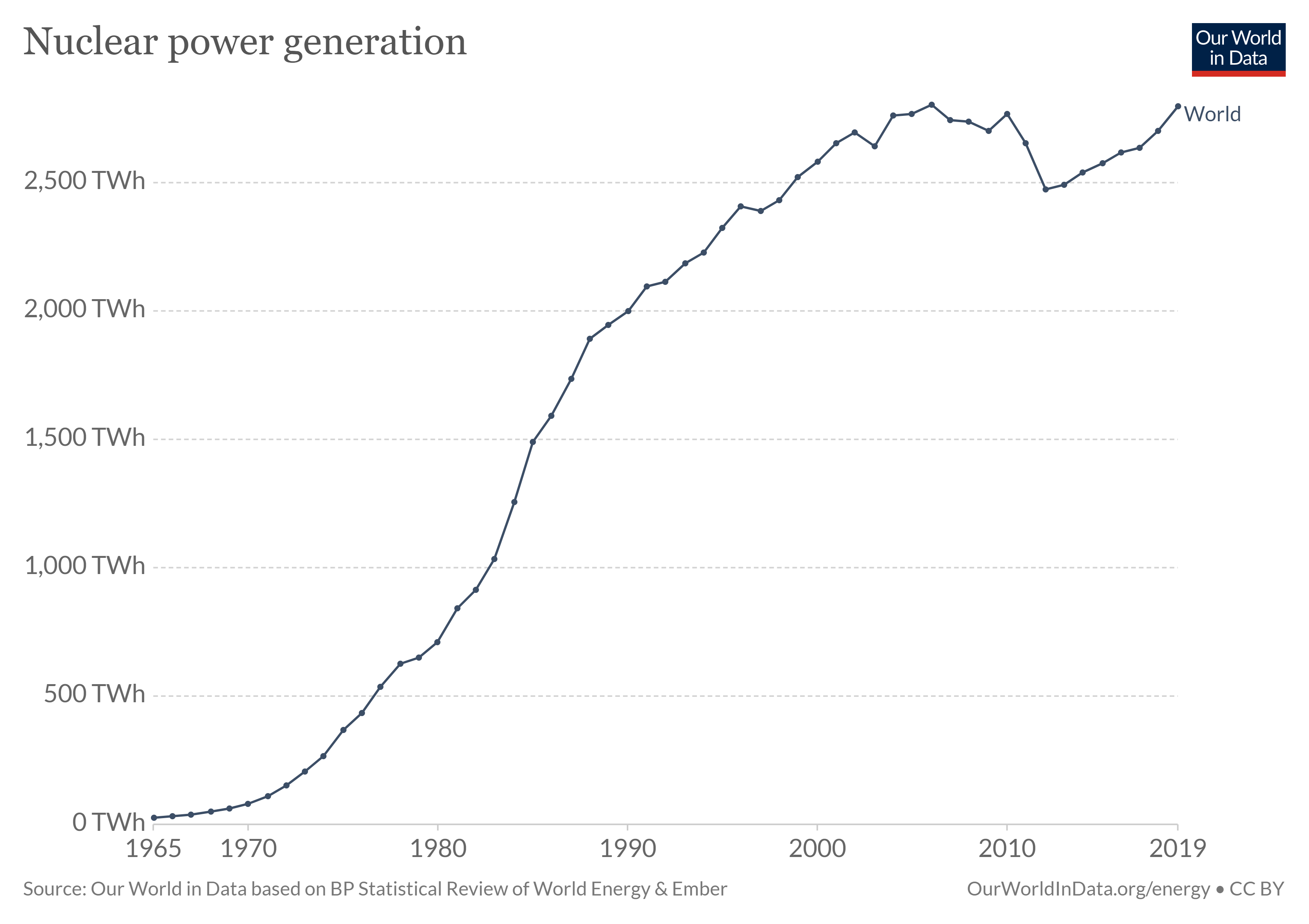
Figure \(\PageIndex{2}\): Global nuclear power generation in TWh over time. Nuclear power production initially increased but remained relative flat in the early 2000s. The dip in 2011 is due to the temporary shutdown of nuclear reactors in Japan following the Fukushima Daiichi Nuclear Power Station meltdown. Image from Hannah Ritchie/Our World in Data (CC-BY).

Figure \(\PageIndex{3}\): U.S. primary energy consumption by energy source in 2019. Nuclear power comprised 8% of total energy consumption in the U.S. Total energy consumption was 100.2 quadrillion British thermal units (Btu). Other source of energy were petroleum (37%), natural gas (32%), coal (11%), and renewable energy (11%).Total renewable energy consumption was 11.4 quadrillion Btu. This includes biomass (43%), wind (24%), hydroelectric (22%), solar (9%), and geothermal (2%). Biomass includes wood (20%), biofuels other than wood and waste (20%), and biomass waste (4%). Note: Sum of components may not equal 100% because of independent rounding. Image by EIA (public domain).
The Nuclear Fuel Cycle
Uranium ore must be mined, milled, and enriched to produce nuclear fuel. The nuclear fuel cycle represents the progression of nuclear fuel from creation to disposal (figure \(\PageIndex{4}\)). The first stage of the nuclear fuel cycle is uranium recovery, in which uranium ore is mined. It is then milled to produce yellowcake (uranium ore concentrate/uranium oxide/U3O8). Milling separates the uranium from the other parts of the ore. Each ton of mined uranium ore typically yields 1-4 pounds of yellowcake (0.05% to 0.20% yellowcake). Next, the uranium ore concentrate is converted into uranium hexafluoride (UF6). It is then enriched to increase the concentration of uranium-235 (235U) relative to 238U. During fuel fabrication, natural and enriched UF6 is converted into into uranium dioxide (UO2) or uranium metal alloys for use as fuel for nuclear power plants. Disposal of spent fuel rods and other hazardous waste generated in this process are discussed in Consequences of Nuclear Energy.

Figure \(\PageIndex{4}\): The nuclear fuel cycle begins with recover (mining) of natural uranium, followed by milling, conversion, and enrichment. The enriched uranium then undergoes fuel fabrication, producing uranium dioxide (UO2) or uranium metal alloys (MOX). The fuel then goes to a nuclear reactor at the power plant. Spent fuel rods are stored in a pool or dry cask, potentially reprocessed, and sent to disposal. Reprocessed uranium can reenter earlier steps of the fuel cycle. Wastes produced during enrichment undergo deconversion before disposal. Image by U.S. NRC (public domain)
Nuclear Reactors
The fuel, which is now in the form of cylindrical ceramic pellets are then sealed into long metal tubes called fuel rods, which are assembled in reactor cores along with control rods. Each fuel pellet, which is about 1 cm in length, stores the same amount of energy as a ton of coal. Thousands of fuel rods form the reactor core, the site of nuclear fission in a nuclear power plant (figure \(\PageIndex{5}\)).
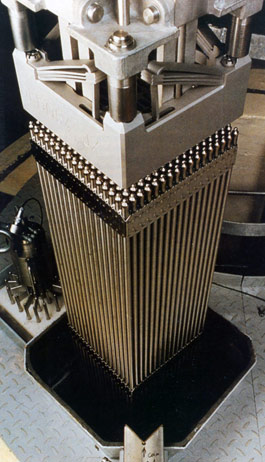
Figure \(\PageIndex{5}\): An assembly of fuel rods containing pellets of nuclear fuel. Image by Alternative Energies and Atomic Energy Commission, France (public domain)
Heat is produced in a nuclear reactor when neutrons strike uranium atoms, causing them to split in a continuous chain reaction that releases heat energy (figure \(\PageIndex{6}\)). Specifically, fission of 235U, releases additional neutrons, which then cause the fission of nearby 235U nuclei. However, if fission occurs in too many atoms simultaneously, too much energy is released, which can cause an explosion or meltdown. This is prevented by control rods, which are made of a material such as boron that absorbs excess neutrons released in nuclear fission. When the neutron-absorbing control rods are pulled out of the core, more neutrons become available for fission, and the chain reaction speeds up, producing more heat. When they are inserted into the core, fewer neutrons are available for fission, and the chain reaction slows or stops, reducing the heat generated.
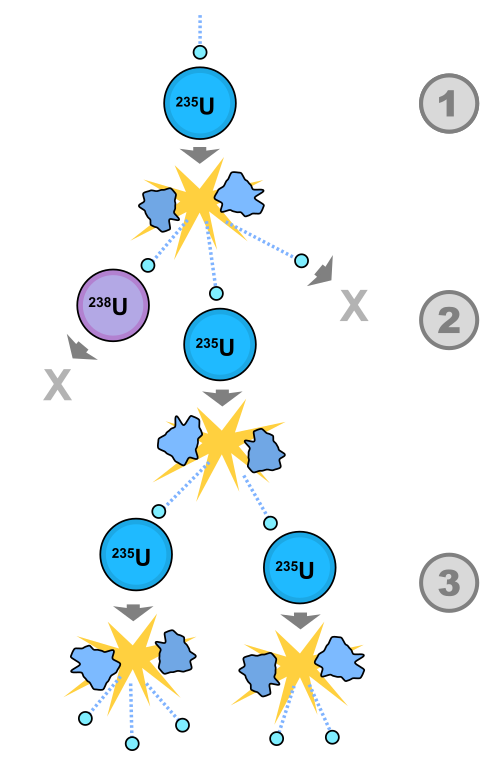
Figure \(\PageIndex{6}\): Schematic diagram of a fission chain reaction. (1) A uranium-235 atom absorbs a neutron, and fissions into two new atoms (fission fragments), releasing three new neutrons and energy. (2) One of those neutrons is absorbed by an atom of uranium-238, and does not continue the reaction. Another neutron is simply lost and does not collide with anything, also not continuing the reaction. However one neutron does collide with an atom of uranium-235, which then fissions and releases two neutrons and some binding energy. (3) Both of those neutrons collide with uranium-235 atoms, each of which fission and release between one and three neutrons, and so on. Image and caption (modified) by Fastfission (public domain).
Nuclear reactors (figure \(\PageIndex{7}\)) contain the reactor core and the machinery needed to generate electricity from the heat released. The reactor core is submerged in water. In addition to transferring heat energy, the water also serves to slow down, or "moderate" the neutrons which is necessary for sustaining the fission reactions. Ultimately, the heat energy is used to generate high-pressure steam, which turns a turbine to generate electricity. The mechanism is similar to that of coal- or natural gas-generated electricity, but nuclear fission rather than combustion of coal is the source of heat energy.

Figure \(\PageIndex{7}\): (1) In a nuclear reactor, fuel rods full of uranium pellets are placed in water. (2) Inside the fuel rods, uranium atoms split, releasing energy. (3) This energy heats water, creating steam. (4) The steam moves through a turbine, which turns a generator to create electricity. (5) In the condensor, the steam cools back into water, which can then be used over again. At some nuclear power plants, extra heat is released from a cooling tower. Image and caption (modified) by EPA (public domain).
There are two main types of nuclear reactors: pressurized water reactors and boiling water reactors.
Pressurized Water Reactor
In a pressurized water reactor, there are three separate streams of water: the water in contact with the reactor core, the water that produces steam, and the cooling water (figure \(\PageIndex{8}\)). The reactor core is submerged in water, which is held by a steel vessel. This is surrounded by a containment structure. As the nuclear fission reaction heats the water surrounding it, the water is pumped in a cyclical stream. It transfers heat to the second stream of water, which is in a separate vessel. This second stream is kept at a lower pressure, allowing the water to boil and create steam The steam turns a turbine, generating electricity. The steam then is cooled in the condenser by a separate stream of cooling water. Because water from the reactor core does not mix with other parts of the reactor, not all of the reactor is radioactive.

Figure \(\PageIndex{8}\): There are three separate streams of water in a pressurized water reactor. The first stream is associated with the reactor core in the reactor pressure vessel. The second stream is associated with the steam generator. The third stream is from an external source and is used to condense the steam. The reactor pressure vessel contains control rods and fuel rods (not labeled). The pressure tank regulates water pressure. Hot water from the reactor moves to the steam generator, where it heats water in the second stream to produce steam. Steam from the steam generator moves through the steam line and turns a turbine, powering the electric generator. Steam cools in the condenser, and the cooled water is then pumped back into the steam generator. The reactor pressure vessel, pressure tank, and steam generator are all in a containment structure. Water from an external source is used to cool steam in the condenser. The water from the external source cools in the cone-shaped cooling tower. Image by Office of Nuclear Energy/ U.S. Department of Energy (public domain).
Boiling Water Reactor
In a boiling water reactor, there are two separate streams of water: the water in contact with the reactor core and the cooling water (figure \(\PageIndex{9}\)). The reactor core heats the water in which it is submerged. This water is held by a steel vessel that is surrounded by a containment structure. The steam produced as the reactor core heats water turns a turbine, which generates electricity. The steam then is cooled in the condenser by a separate stream of cooling water. Because water from the reactor core comes in contact with all parts of the reactor, the entire thing is radioactive.
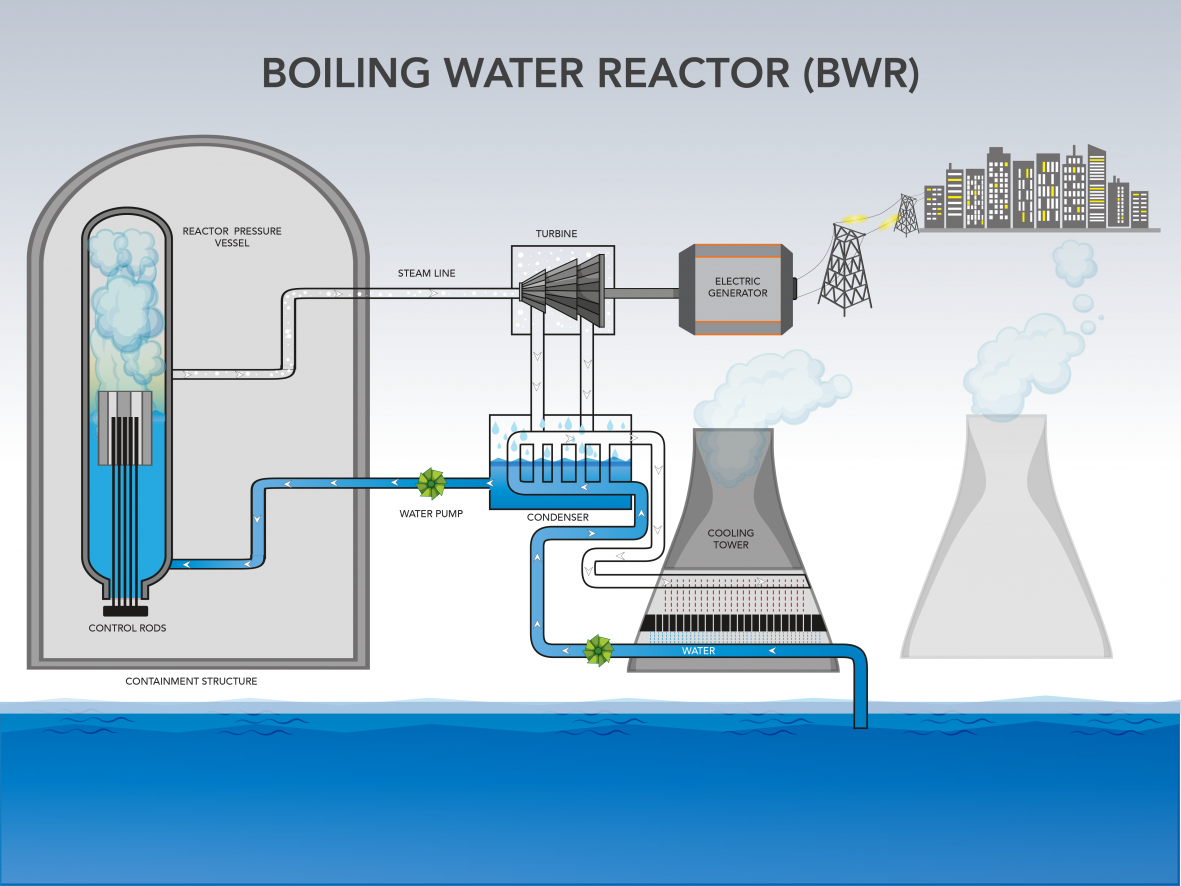
Figure \(\PageIndex{9}\): A boiling water reactor has two streams of water. In the first stream, the same water that bathes the reactor core in the reactor pressure vessel and turns to steam and turns a turbine. The third stream is from an external source and is used to condense the steam. The reactor pressure vessel contains control rods and fuel rods (not labeled). It is within a larger containment structure. When water is heated by the reactor, it evaporates to steam. This moves through the steam line and turns a turbine, powering the electric generator. Steam cools in the condenser, and the cooled water is then pumped back into the reactor pressure vessel. Water from an external source is used to cool steam in the condenser. The water from the external source cools in the cone-shaped cooling tower. Image by Office of Nuclear Energy/ U.S. Department of Energy (public domain).
Advantages of Nuclear Energy
In contrast to fossil fuels, generating electricity from nuclear energy does not pollute the air or significantly contribute to climate change (figure \(\PageIndex{10}\)). As we continue to deplete global reserves of fossil fuels, supplies of nuclear fuel are abundant. It is estimated that uranium supplies will last over 200 years, and there is potential to use other radioactive isotopes as well. 
Figure \(\PageIndex{10}\): Nuclear energy causes fewer deaths and releases miniscule greenhouse gases compared to fossil fuels. These bar graphs explore the question, "What are the safest and cleanest sources of energy?". On the left is the death rate from accidents and air pollution measured as deaths per terawatt-hour (deaths/TWh) of energy production. 1 terawatt-hour is the annual energy consumption of 27,000 people in the European Union (EU). On the right are greenhouse gas emissions measured in tonnes of CO2-equivalents emitted per gigawatt-hour (tCO2-eq/gWh) of electricity over the lifecycle of the power plant. 1 gigawatt-hour is the annual electricity consumption of 160 people in the EU. Coal accounted for 24.6 deaths/TWh, 25% of global energy, and 820 tCO2-eq/gWh. Oil accounted for 18.4 deaths/TWh, 31% of global energy, and 720 tCO2-eq/gWh. Coal accounted for 2.8 deaths/TWh, 23% of global energy, and 490 tCO2-eq/gWh. Biomass accounted for 4.6 deaths/TWh, 7% of global energy, and 78-230 tCO2-eq/gWh. Hydropower accounted for 0.02 deaths/TWh, 6% of global energy, and 34 tCO2-eq/gWh. Nuclear energy accounted for 0.07 deaths/TWh, 4% of global energy, and 4 tCO2-eq/gWh. Wind accounted for 0.04 deaths/TWh, 2% of global energy, and 4 tCO2-eq/gWh. Coal accounted for 0.02 deaths/TWh, 1% of global energy, and 5 tCO2-eq/gWh. Coal caused 1230 times more deaths than solar, and oil caused 263 times more deaths than nuclear energy. Coal emissions were 273 times higher than nuclear energy, and oil emissions were 180 times higher than wind. Image by Hannah Ritchie and Max Roser/Our World in Data (CC-BY).
Furthermore, nuclear power plants are more reliable than any other source, with a capacity factor of 93.5% (figure \(\PageIndex{11}\)). Capacity is the amount of electricity a generator can produce when it’s running at full blast, and the capacity factor is a measure of how often a plant is running at maximum power. (A power plant with a capacity factor of 100% means that it's producing power all of the time.)

Figure \(\PageIndex{11}\): The capacity factor of six energy sources in 2019. Nuclear has the highest capacity factor at 93.5% followed by natural gas (56.8%), coal (47.5%), hydropower (39.1%), wind (34.8%), and solar (24.5%). Image from Office of Nuclear Energy/ U.S. Department of Energy (public domain).
Negative Impacts of Nuclear Energy
Despite its benefits, nuclear power has downsides. It requires more water than any other energy source. Water used for cooling is released back into the environment, and while it does not contain radioactive materials or other harmful chemicals, it is warmer than before. This is called thermal pollution, and it can harm aquatic life, which are adapted to cooler temperatures. Surface mining for uranium ore degrades habitat and releases toxins from underground (similar to surface mining for coal). Nuclear power plants are expensive to build and maintain, and they require large amounts of metal and concrete. Enriched uranium for nuclear fuel if in the wrong hands can be used to make nuclear weapons (figure \(\PageIndex{12}\)). While nuclear accidents are rare, they can cause great harm, and their impacts are long-lasting. Furthermore, the problem of safely disposing spent nuclear fuel remains unresolved. The latter two concerns are discussed in more detail below.
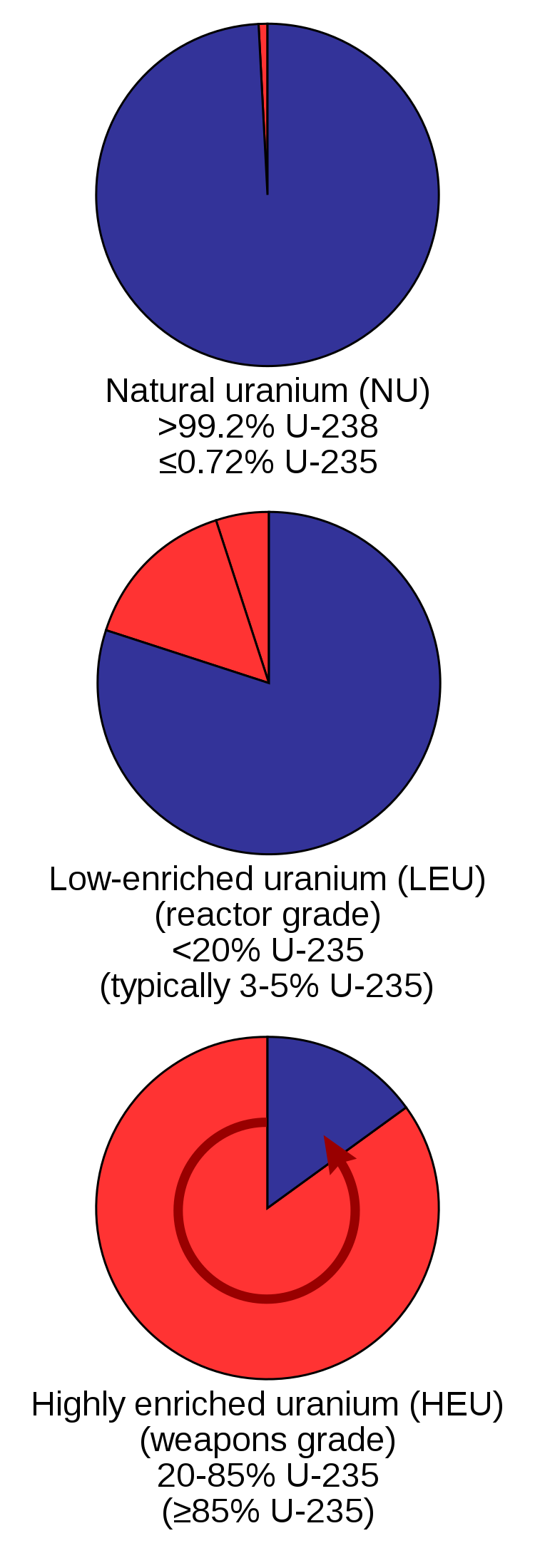
Figure \(\PageIndex{12}\): Pie charts showing the relative proportions of uranium-238 (blue) and uranium-235 (red) at different levels of enrichment. Nuclear weapons require more highly enriched uranium than is needed for nuclear fuel. Natural uranium (NU) consists of more than 99.2% U-238 and 0.72% or less of U-235. Low-enriched uranium (LEU) consists of less than 20% U-235, with reactor-grade uranium typically 2-5% U-235. High-enriched uranium (HEU) consists of 20-85% U-235 with weapons grade at least 85% U-235. Image and caption (modified) by Fastfission (public domain).
Nuclear Waste
The main environmental challenge for nuclear power is the wastes including high-level radioactive waste, low-level radioactive waste, and uranium mill tailings. These materials have long radioactive half-lives and thus remain a threat to human health for thousands of years.
High-level radioactive waste (HLRW) consists of used nuclear reactor fuel (spent nuclear fuel rods). These contain the products of nuclear fission, which are radioactive themselves. This HLRW is temporarily stored in a pool at the nuclear power plant or a dry cask, steel cylinders within another container, made of steel or concrete (figure \(\PageIndex{13}\)). Dry casks contain inert (nonreactive) gas and may be located at the power plant, a decommissioned power plant, or a separate storage site. High-level radioactive waste may only be moved to a dry cask after one year of cooling in a pool. The U.S. has no long-term storage for HLRW, and spent fuel thus remains interim storage.
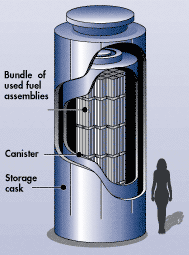
Figure \(\PageIndex{13}\): Dry casks seal spent fuel rods in a canister, which is surrounded by a larger storage cask. Bundles of used fuel assemblies are inside. Image by NRC (public domain).
Yucca Mountain in Nevada was proposed as a long-term geologic storage site, where HLRW could be buried for hundreds of thousands of years. The storage facility was constructed, but it has not been used due to opposition from local residents and concern about the safety of transporting HLNW (figure \(\PageIndex{14}\))

Figure \(\PageIndex{14}\): Yucca Mountain is the proposed site for long-term storage of high-level radioactive waste in the U.S., but it is not in use due to political controversy. Image by whitehouse.gov (public domain).
Some countries reprocess (recycle) spent nuclear fuel, but no recycling or reprocessing facility or a federal waste repository is currently licensed in the United States. Reprocessing separates the useable fraction of spent fuel and recycles it through the reactor, using a greater fraction of its energy content for electricity production, and sends the remaining high-level waste to permanent geologic storage.
The primary motivation for reprocessing is greater use of fuel resources, extracting about 25 percent more energy than the once through cycle. A secondary motivation for recycling is a significant reduction of the permanent geologic storage space (to 20% or less of what would otherwise be needed) and time (from hundreds of thousands of years to thousands of years). While these advantages seem natural and appealing from a sustainability perspective, they are complicated by the risk of theft of nuclear material from the reprocessing cycle for use in illicit weapons production or other non-sustainable ends. At present, France, the United Kingdom, Russia, Japan, and China engage in some form of reprocessing; the United States, Sweden, and Finland do not reprocess.
Low-level radioactive waste (LLRW) refers to items that were exposed to radiation includes clothing, filters, and gloves. These can be contained with concrete or lead (through which radiation cannot pass; figure \(\PageIndex{15}\)).
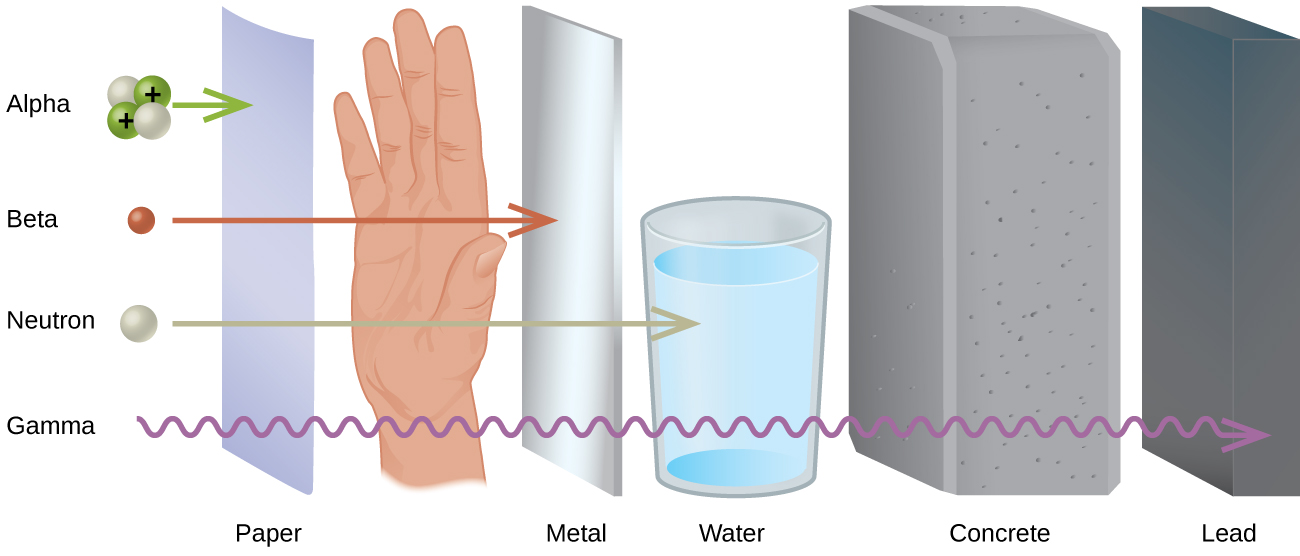
Figure \(\PageIndex{15}\): Water, thick concrete, lead, and steel (not shown) can stop several types of radiation released from radioactive wastes. Note that gamma rays can somewhat penetrate all of these substances, but lead, concrete, and steel provide a partial shield. The ability of different types of radiation to pass through material is shown. From least to most penetrating, they are alpha < beta < neutron < gamma. The top particle listed is made up of two white spheres and two green spheres that are labeled with positive signs and is labeled “Alpha.” A right-facing arrow leads from this to the paper. The second particle is a red sphere labeled “Beta” and is followed by a right-facing arrow that passes through the paper and stops at the hand. The third particle is a white sphere labeled “Neutron” and is followed by a right-facing arrow that passes through the paper, hand and metal but is stopped at the glass of water. The fourth particle is shown by a squiggly arrow and it passes through all of the substances but stops at the lead. Terms at the bottom read, from left to right, “Paper,” “Metal,” “Water,” “Concrete” and “Lead.” Image and caption (modified) from Flowers, Theopold, and Langley/OpenStax (CC-BY). Download for free at CNX.
Low-level waste is typically stored at the nuclear power plant, either until it has decayed away and can be disposed of as ordinary trash, or until amounts are large enough for shipment to one of the five LLRW disposal sites in the U.S. (figure \(\PageIndex{16}\)).
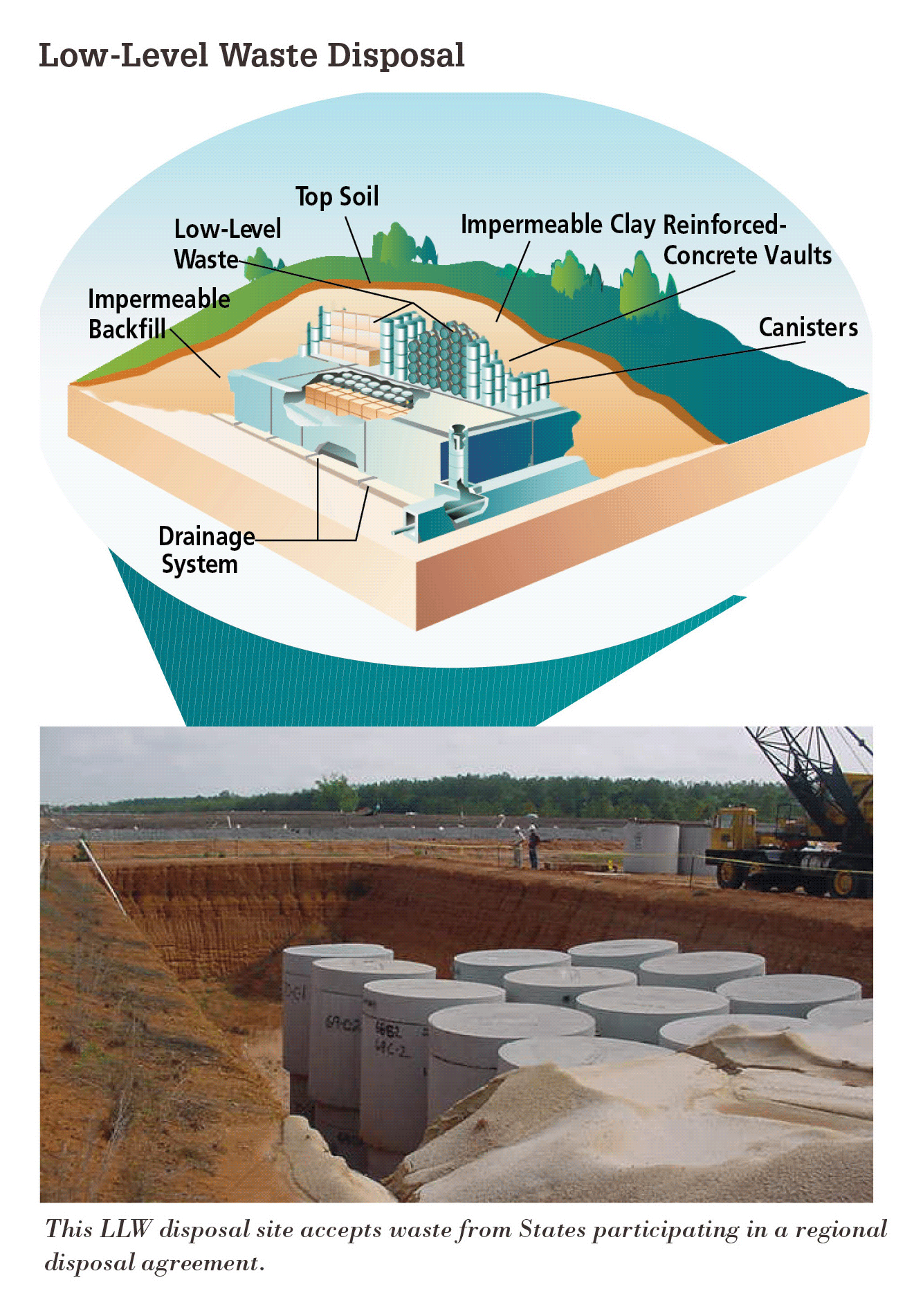
Figure \(\PageIndex{16}\): Diagram (top) and photo (bottom) of a low-level radioactive waste (LLRW or LLW) disposal site. In the diagram, low-level waste is contained in canisters within concrete vaults. This is surrounded by impermeable clay and backfill. The drainage system prevents the wastes from contaminating groundwater. The entire disposal facility is underground, and a layer of top soil is above it. The disposal site in the photo accepts waste from States participating in a regional disposal agreement.The waste is sealed in canisters and shallowly buried. Image by NRC (public domain).
Enrichment of uranium produces depleted uranium hexafluoride (DUF6), or uranium mill tailings, as a byproduct, which does not have high enough concentrations of 235U to use as nuclear fuel but is still hazardous. Tailings represent the greatest percentage of nuclear waste by volume, and there are more than 200 million tons of radioactive mill-tailings in the United States. Tailings contain several radioactive elements including radium, which decays to produce radon, a radioactive gas. They are stored in impoundments, lined pits in the ground that are flooded with water, in remote areas. Deconversion involves chemically treating the tailings to reduce their hazards so that they can be stored as LLRW.
Nuclear Disasters
There are many other regulatory precautions governing permitting, construction, operation, and decommissioning of nuclear power plants due to risks from an uncontrolled nuclear reaction. The potential for contamination of air, water and food is high should an uncontrolled reaction occur. Even when planning for worst-case scenarios, there are always risks of unexpected events. The nuclear accidents at Three Mile Island, Chernobyl, and Fukushima raised concerns about the safety of nuclear power.
The Three Mile Island accident occurred in Pennsylvania in 1979. It was a partial meltdown that resulted from an electrical failure and errors in operation. There were no direct deaths. Studies investigated the possibility of exposure to radiation from the accident indirectly causing deaths through increased rates of cancer or other disease, but there has not been evidence of this. In contrast, the 1986 meltdown at Chernobyl Nuclear Power Plant in what is now the Ukraine was responsible for 50 direct deaths. This disaster occurred from a test of the emergency systems gone wrong. Estimates of indirect deaths from radiation exposure range from 4,000 to 60,000.
The global discussion regarding nuclear energy has been strongly impacted by March 2011 earthquake and subsequent tsunami that hit Japan resulted in reactor meltdowns at the Fukushima Daiichi Nuclear Power Station causing massive damage to the surrounding area. The disaster disabled the cooling system for a nuclear energy complex, ultimately causing a partial meltdown of some of the reactor cores and release of significant radiation. The design of the reactors (boiling water reactors) made it more difficult to vent the system without releasing radiation. Cooling the radioactive fuel generated a large volume of contaminated water, and the disaster costed at least $300 billion dollars. While there were no immediate deaths, one person later died from cancer attributed to radiation exposure. Thousands died as a result of stress associated with the evacuation, and about 20% of the over 160,000 evacuees had not yet returned home as of 2019.
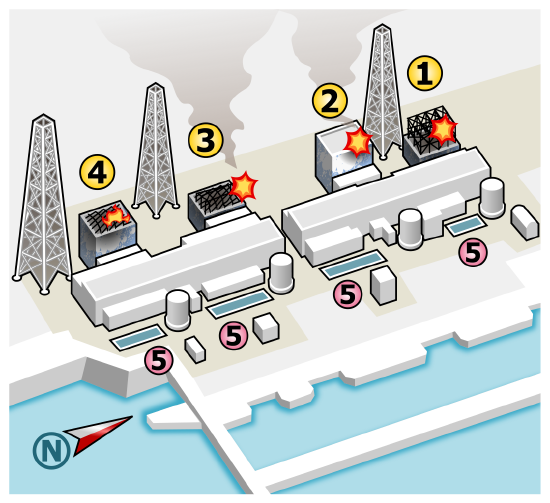
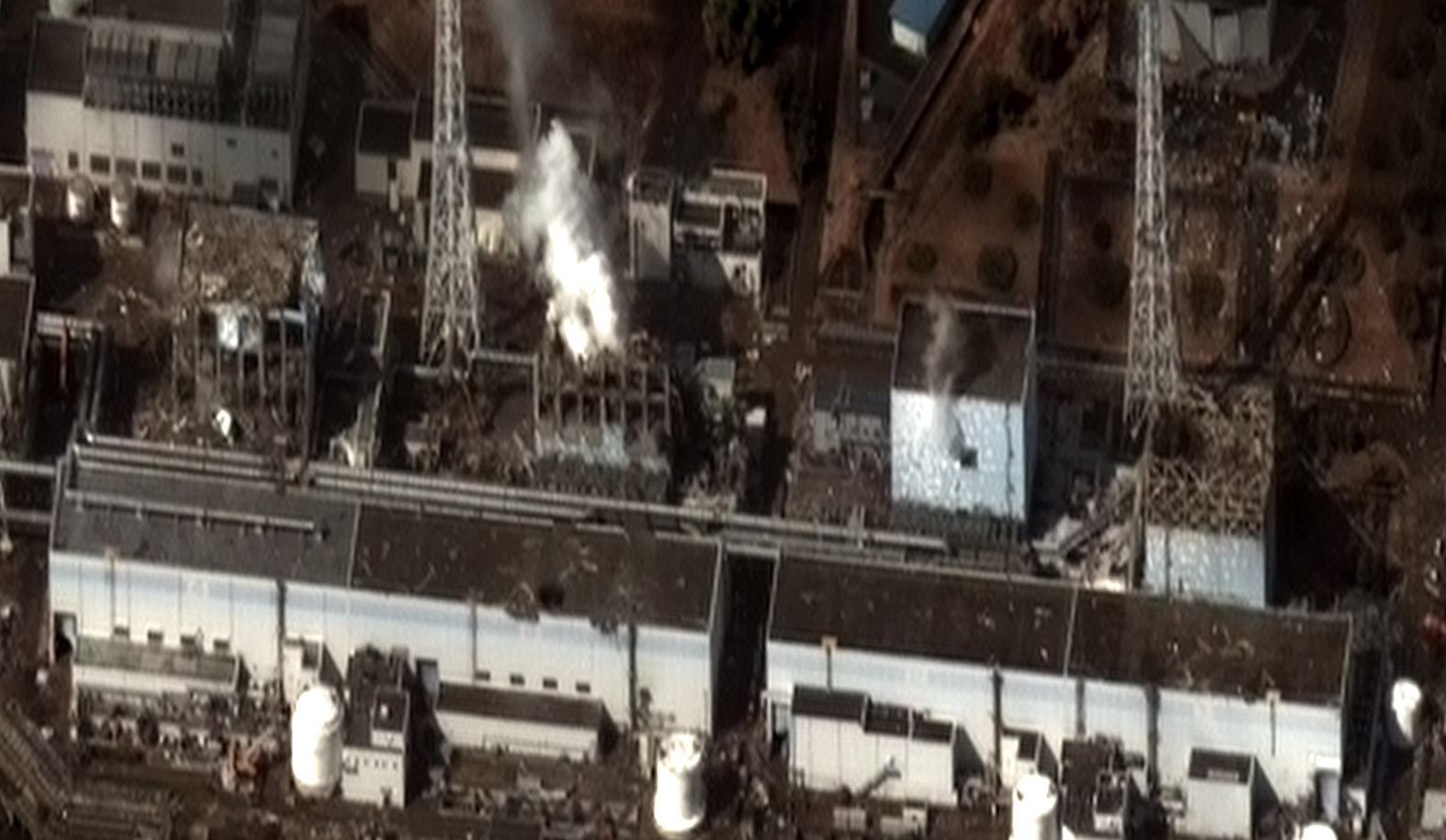
Figure \(\PageIndex{17}\): Left: Diagram (approximate) of the Fukushima I Nuclear Power plant accidents. (1) Unit 1: Explosion, roof blown off on 12 March. (2) Unit 2: Explosion on 15 March; contaminated water in underground trench, possible leak from suppression chamber. (3) Unit 3: Explosion, most of concrete building destroyed on 14 March, possible plutonium leak. (4) Fire on 15 March; water level in spent fuel pools partly restored. (5) Multiple trenches: probable source of contaminated water, partly underground, leaked stopped on 6 April. Right: The Fukushima I Nuclear Power Plant after the 2011 Tōhoku earthquake and tsunami. Reactor 1 to 4 from right to left. Left image and caption (modified) by Sodacan (CC-BY). Right image and caption by Digital Globe (CC-BY-SA).
To learn more about the Fukushima you can watch this three-minute segment, What Recovery Looks Like In Japan Almost A Decade After Fukushima Nuclear Disaster, which provides on update on evacuees from the Fukushima nuclear disaster.
Attribution
Modified by Kyle Whittinghill and Melissa Ha from the following sources:
- Non-renewable Energy Sources from AP Environmental Science by University of California College Prep (CC-BY). Download for free at CNX.
- Stages of the Nuclear Fuel Cycle. 2020. U.S. NRC. Accessed 01-16-2021 (public domain).
- Nuclear explained: The nuclear fuel cycle. 2020. U.S. Energy Information Administration. Accessed 01-16-2021 (public domain).
- Non-Renewable Energy Sources from Environmental Biology by Matthew R. Fisher (licensed under CC-BY)
- Nuclear Energy, Environmental Challenges in Energy, Carbon Dioxide, Air, Water and Land Use, and Systems of Waste Management from Sustainability: A Comprehensive Foundation by Tom Theis and Jonathan Tomkin, Editors. Textbook content produced by Tom Theis and Jonathan (CC-BY). Download for free at CNX.
- What is Generation Capacity? 2020. Mike Mueller. Office of Nuclear Energy. U.S. Department of Energy. Accessed 01-16-2021 (public domain)


